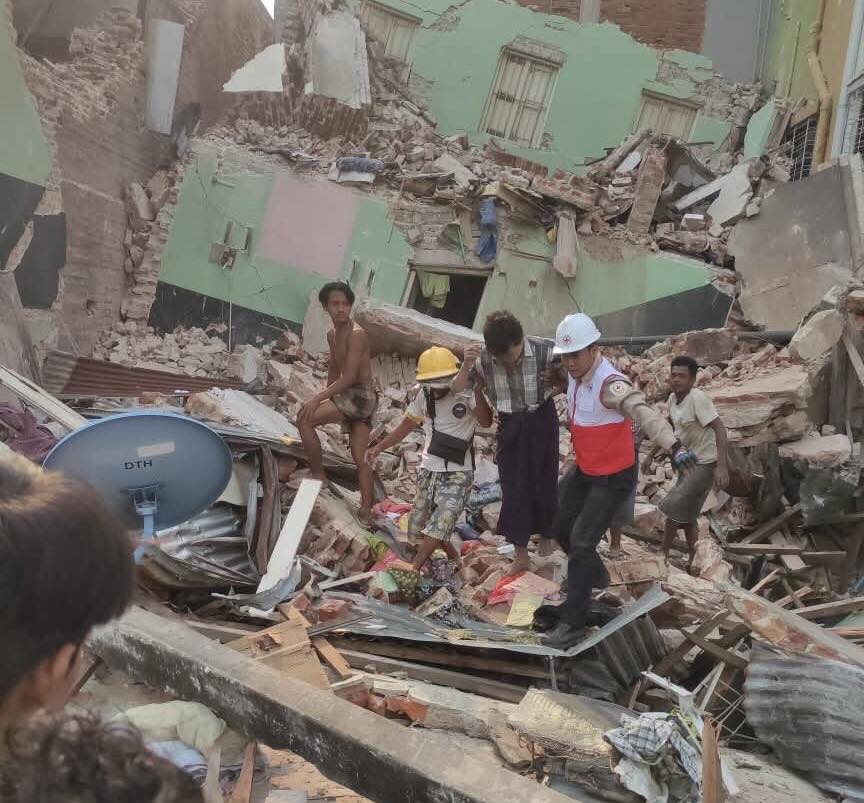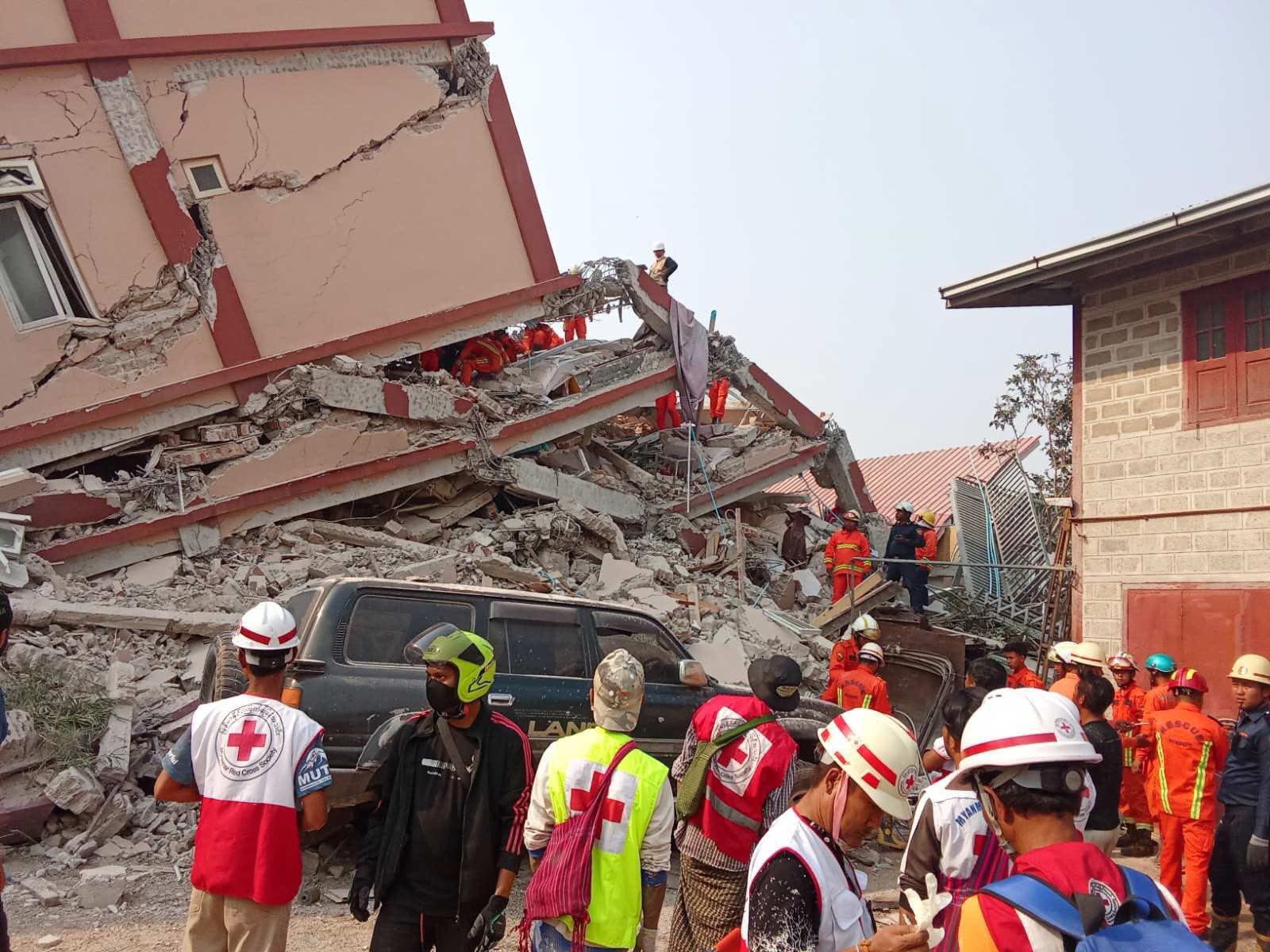Areas around Mandalay and Sagaing were left in ruins after a deadly earthquake struck Myanmar in March, the sheer force of nature crystalizing the ongoing conflict between the junta and rebel forces. The tragedy, compounded by years of war and instability, saw both sides momentarily unite in response.
When a 7.7 magnitude earthquake with an epicenter near Mandalay, Myanmar, hit on March 28, the shaking brought down buildings that once stood strong, fortified with concrete and steel. Some crumbled to the ground and others ripped apart as if made of styrofoam. A magnitude 6.4 aftershock followed just 12 minutes later, amplifying the destruction, and together, they wreaked havoc across multiple countries, cleaving open roads and collapsing structures as far as Thailand and southwest China.
In Myanmar alone, more than 3,700 people were killed and some 5,100 were injured, with at least 100 others still missing. Experts believe actual tolls are likely much higher, with on-ground challenges compounded by the country’s perpetual state of unrest and the challenges of reporting from such areas.
“Myanmar is such an information black hole that I think the earthquake really sort of just increased the fog around information,” Factal’s Asia-Pacific regional lead Vivian Wang said.
In the aftermath of the earthquake, the already fragile state of Myanmar’s political fabric and government became even more evident, as long-standing conflicts and the military’s grip on power appeared to deepen the damage of the tremor.
The military directly controlled Myanmar for decades until 2015, when a brief experiment with democracy ended abruptly in a 2021 coup d’etat that ousted Aung San Suu Kyi’s government and brought the Tatmadaw back to power. The takeover sparked mass protests and saw the rapid rise of “people defence forces” (PDFs), as protesters realized they could not peacefully resist the army. The same Suu Kyi administration had also overseen the military’s “ethnic cleansing” campaign in Rakhine, a Muslim-majority area stripped of citizenship rights, giving rise to its own armed resistance, the Arakan Army.
However, the sheer force of the March 28 earthquake seemed to crystalize the conflict. The chaos that followed almost fossilized the frontlines – almost. A tenuous ceasefire, extended several times to allow for disaster relief, expired on April 30 with no immediate word on renewing it as regional countries called for another extension.
“The story coming from the rebel side versus the junta side is obviously conflicting, but the rebel side claims that the air strikes continued, even almost directly after the earthquake”
“The major rebel groups in the area did declare unilateral ceasefires pretty quickly after the earthquake, and the junta did not,” Wang said. “The junta claims they were protecting themselves from rebel forces taking advantage of the situation. Even when they did declare one, they put a major caveat, saying, ‘If we think that you are trying to coalesce forces,’ they reserve the right to ‘defend themselves’.”
Tensions remained high despite the ceasefire efforts. Within a week of the earthquake, the junta and the rebels were exchanging blame over exchanging fire.
“The story coming from the rebel side versus the junta side is obviously conflicting, but the rebel side claims that the air strikes continued, even almost directly after the earthquake,” Wang explained.
Even before the earthquake exposed the junta’s vulnerabilities, Myanmar’s rebel forces had been making significant territorial gains.
“They control an astonishing percentage but it’s in less populated areas. The places that are under rebel control don’t make up a lot of the population of Myanmar. But in terms of land mass, it’s a lot of it,” Wang said. “A lot of the Myanmar-China border has been taken over by rebels, and also the Myanmar-Thailand border.”
As of November 2024, a patchwork of defense forces and rebels appeared to control more than 40 percent of Myanmar’s territory, though only 18 percent of its urban areas. Still, cities are not off-limits by any means. Myawaddy, a key trade city on the Thai border, fell into the hands of Karen National Liberation Army (KNLA), one of the many resistance forces, on April 9. Though by April 24, the KNLA had lost control, accusing a rebel faction that splintered from the junta of allowing the troops back in.
“The resistance forces, which are manifold from people’s defense forces to ethnic militias, work concurrently in tandem across the country,” Wang said.
“China is the obvious answer to fill the void of U.S. aid being pulled.”
“The major groups are what we would consider to be the armed wings of the shadow National Unity Government, which are loosely referred to as the people’s defense forces which have their regional offshoots in each area. And the other one is the Three Brotherhood Alliance – they launched the Oct. 27 offensive that took control of a lot of the northeast,” Wang said.
“They have different goals in mind. The PDFs want to restore the rule of law under the national unity government, and the Arakan Army is more interested in gaining some kind of autonomy [for Rakhine]. But they’ve got a common enemy.”
The conflict lines stretch from eastern Bangladesh and India, up to southwest China and down to Thailand’s western border. Both Beijing and Bangkok are warily observing Myanmar’s civil war, with China wielding more influence.
On April 21, control Lashio in northern Shan State was returned to the junta by the Myanmar National Democratic Alliance Army (MNDAA), a rebel group originating from the Kotang region along the China border since 1989. The city, once the junta army’s northeast command, was taken by the MNDAA in July 2024, but China brokered an alleged power-sharing deal, overseeing the resultant ceasefire in Shan’s largest city.
“China’s interest is definitely stability in Myanmar, under whoever [is in charge]. It comes down to border security … because it is a pretty significant border,” Wang said. ”China has also tried to mediate between the Three Brotherhood Alliance and the junta for ceasefires along the border and they have inroads there because these are ethnically Chinese parts of Myanmar.”
As humanitarian agencies in Myanmar scramble for sufficient funding to provide water, food and basic shelter for tens of thousands of displaced people ahead of the upcoming cyclone and monsoon season, the Trump administration’s cuts to U.S. aid have a far-reaching impact.
“The U.S. was, in most people’s estimations, responsible for funding probably most NGOs operating in Myanmar at the time, so to have all of their and independent media’s funding cut off so soon … really pulled out the rug from under them,” Wang said.
“China is the obvious answer to fill the void of U.S. aid being pulled. With the shared border so big, as is with Thailand, those are the most obvious and immediate partners in the region, and they don’t seem so invested in keeping the junta in power so much as they are interested in there finally not being conflict in Myanmar and at their border.”
For now, Myanmar’s regional partners appear content with allowing the junta leeway in its desire to gain international recognition. Just days after the devastation, Myanmar’s army chief Gen. Min Aung Hlaing landed in Bangkok for regional talks.
“The junta is planning to hold elections at the end of this year, even after this earthquake. So we’ll see kind of where that takes us in terms of them attaining the veneer of legitimacy,” Wang added.
Further reading:
- Review Factal’s coverage of Myanmar’s civil war on our topic page (members link) or stay informed about updates related to the earthquake here (members link)
- Read this investigation by Bellingcat into junta airstrikes despite earthquake ceasefire
- Watch “Myanmar’s Killing Fields,” a PBS Frontline documentary on the junta’s brutal campaign to eradicate the Rohingya Muslim minority in Rakhine State
- For weekly analysis, sign up for this free news round-up by Frontier Myanmar

Top photo: Myanmar Red Cross teams assist people on March 29, a day after the devastating magnitude 7.7 earthquake struck near Mandalay. (Image/Red Cross Photo)
If you like what you’re reading, sign up to receive The Debrief in your inbox on the first of every month here.
Factal gives companies the facts they need in real time to protect people, avoid disruptions and drive automation when the unexpected happens.
Try Factal for free or talk with our sales team (sales@factal.com) for a demo.

